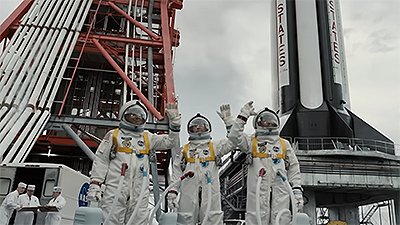A long night at the museum
History comes alive?
It’s the #1 movie in America again this week. With high-tech special effects and its movie stars, Night at the Museum has already grossed $125 million in just 11 days, as moviegoers continue to flock to theaters to take a peek at a very bizarre natural history museum. Because AiG opens its own high-tech Creation Museum in late May, and after being told by a friend1 that this new release had some evolutionary content, I had sufficient reasons to go to my local theater and see if Night at the Museum merits the claim of being this holiday’s blockbuster.

History will come alive in AiG’s own Creation Museum. This will include the lobby’s animatronic dinosaurs, which will move quite realistically. Baby T. rexes (to the bottom right in this photo and next to the pool) and a large sauropod dinosaur (in the foreground) will help make a day at this museum an edu-taining experience for all who visit.
A fantasy film, the movie stretches its thin plot-line to a long 100 minutes, and along the way proceeds to stretch credulity to a breaking point even for a fantasy. The storyline involves a museum’s mannequins and stuffed animals (and a T. rex skeleton) coming to life. Inanimate objects that come to life is not an infrequent plot device in movies in recent times (e.g., the Toy Story films).
The film’s setting is called the “Museum of Natural History” in New York City.2 The evolutionary content in the movie includes: 1) stick- and stone-wielding brutish Neandertals, who come alive in their exhibit and, as clueless cavemen, try to make fire; 2) a declaration by Robin Williams, who portrays US President Teddy Roosevelt,3 that monkeys are our “primate brothers,” and that if we didn’t have the monkeys, “there’s no us”; 3) a night-guard (the film’s main actor, Ben Stiller) is chastised by Teddy after having a spat with a monkey and is asked the question: “Who has evolved? Who has evolved?” (i.e., you or the monkey?). But the evolutionary content is not very dominant in what, after all, is a film of fantasy-comedy. It shouldn’t be considered an evolutionary propaganda piece.
At the same time, this film demonstrates once again how evolutionary beliefs continue to permeate the Western culture (see Carl Kerby’s new book, Remote Control, on this very theme). Accordingly, some caution should be offered for those parents who are thinking of taking their children to see Night at the Museum. At least by Hollywood standards, the movie, rated PG, is relatively clean, although Jumanji-like4 rampaging animals (including a vicious T. rex) would likely scare most children. Discerning parents should be aware of this, and if they still decide to see the movie with their children, they should offer the correct, biblical teaching of biological origins in order to counter the evolution presented in the movie.
“Larry” (Stiller) is one of the museum’s security officers. He is swept up in the antics and all the havoc when the exhibits spring to life at night after museum visitors leave. In typical Hollywood fashion, Larry is a part of a dysfunctional family. He has a 10-year-old son who lives with his ex-wife and her boyfriend. The redeeming aspect of the movie is that Larry tries to do well for his son and to be seen as a positive role model.
The American Natural History Museum of New York agreed to cooperate with filmmakers and be the setting for the movie. No doubt museum curators there and elsewhere hope that a popular movie with major stars like Stiller and Williams will prompt more people to consider a visit to their museums. For our part, AiG hopes that children who watch this film (or as a DVD later) will become aware of its Creation Museum in northern Kentucky, and that they will ask their parents to bring them to the Creation Museum so that they can take in its high-tech exhibits and fascinating dinosaur displays (including moving ones).
I did find myself agreeing with one aspect of the movie. In a scene, a docent tells a group of young people that the more you know about the past, the better you’ll be prepared for the future. Indeed, as people examine the real history of the world according to the Bible (which is a main theme of AiG’s museum), we hope they will come to the realization that their future will only be secure if they place their trust in a historical Christ, and believe the Bible’s accounts of His death, burial, and resurrection 2,000 years ago—which He accomplished to save us from our sins so that our eternal future will be secure with Him in heaven.
And to think that this very real, high-tech Creation Museum—with its real-life message of hope in Christ—is being built for only one-fifth of what this fantasy film has raised is a testimony to how God is blessing this evangelistic center.
Footnotes
- I could hardly ignore the request of this person, our local US Congressman. He suggested to me at church on Sunday that I should see the film, not only because he is a booster of AiG’s Creation Museum, but also because he wanted to let us know there was some evolutionary content in the film.
- For the movie, the museum’s real name was slightly altered from the “American Museum of Natural History” to the “Museum of Natural History.” The AMNH cooperated in the making of the film, and it appears that façade of the real museum was used in some shots. This is the same AMNH that hosted the controversial, massive “Darwin” exhibition for nine months, until it closed last August; the exhibit was very well-attended (it continued its run for a few months beyond its originally scheduled closing date). Read our review of the AMNH “Darwin” exhibit.
- By the way, Roosevelt, according to a biography I am now reading (Theodore Rex) was a committed evolutionist.
- Jumanji was a film that also starred Robin Williams.
Recommended Resources

Answers in Genesis is an apologetics ministry, dedicated to helping Christians defend their faith and proclaim the good news of Jesus Christ.
- Customer Service 800.778.3390
- © 2025 Answers in Genesis







